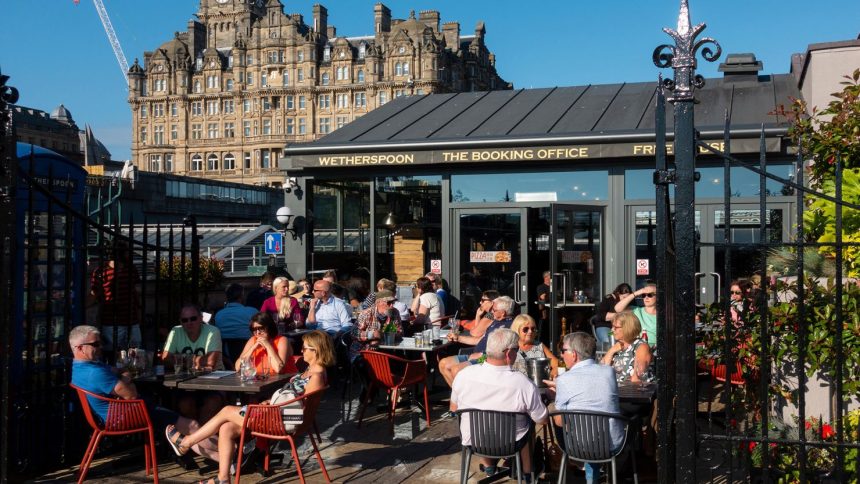Editor’s note: Sign up for Unlocking the World, CNN Travel’s weekly newsletter. Get news about destinations, plus the latest in aviation, food and drink, and where to stay.
London
CNN
—
Utter the single word “Wetherspoon,” or even the colloquial “Spoons” to a Brit, and they’ll know what you mean. Some will grimace. Some will groan. Others will excitedly rub their hands together like you’d just cooked their favorite meal.
Wetherspoon pubs are an institution in the UK. They enjoy cult-like status both among admirers, lured in by real ale and “pub grub” sold at astoundingly low prices, and detractors, who see them as emblematic of everything that’s wrong with modern Britain.
More than 800 Wetherspoon chain pubs freckle the country — from The Muckle Cross in Scotland to The Tremenheere in Cornwall. In just a few decades, “Spoons” have become so ingrained into British daily life that they probably now deserve to be up there with Stonehenge on the list of UK cultural institutions.
For outsiders, the Wetherspoon concept can take some unpacking.
Many are the unsuspecting tourists who find themselves baffled by one of these vast drinking establishments, sometimes documenting their experiences on social media with the same breathless wonder as explorers entering uncharted rainforest.
The story of the “Spoons” starts, surprisingly, with English writer George Orwell, the man behind the chilling dystopian fiction of “1984.”
Orwell had robust opinions on totalitarianism, surveillance, censorship and class struggle. He also had things to get off his chest about treacle tarts and cups of tea. “How can you call yourself a true tea-lover,” he cried in “A Nice Cup of Tea”, his 11-point plan for brewing a textbook cuppa, “if you destroy the flavour of your tea by putting sugar in it?”
With “In Defence of English Cooking” Orwell railed against Francophile foodies, instead extolling the virtues of kippers, Oxford marmalade and new potatoes slicked with melted butter and mint. A keen baker, he also jotted down his own recipes for plum cake and Yorkshire puddings. Biscuits, the author insisted, were “better and crisper in England.” Now there’s a “The Great British Bake-Off” episode we’d all tune into.
Of all the “Animal Farm” author’s refreshment-themed essays, though, 1946’s “The Moon Under Water” is his best-known. In this romantic wish list of components for the perfect pub, Orwell’s fantasy boozer is frequented by regulars who sit in the same chair night after night, employs chirpy, liver-sausage-sandwich-slinging barmaids, and serves its ale in strawberry-pink china mugs. “…most people like their drink to be transparent,” wrote Orwell, “but in my opinion beer tastes better out of china.”
The name “Moon Under Water” nudged its way back into the British public consciousness in April 2021, when a podcast of that name was launched — celebrity guests cobbling together their own pub paradigms: what they’d play on the jukebox, which brews they’d pour.
It struck a chord: three years, and over 300 episodes later, the podcast is still streaming. Yet you could argue that a far more substantial, brick-and-mortar tribute to Orwell’s dream pub had already been going for some four decades before that. Its name: J D Wetherspoon.
The Moon Under Water
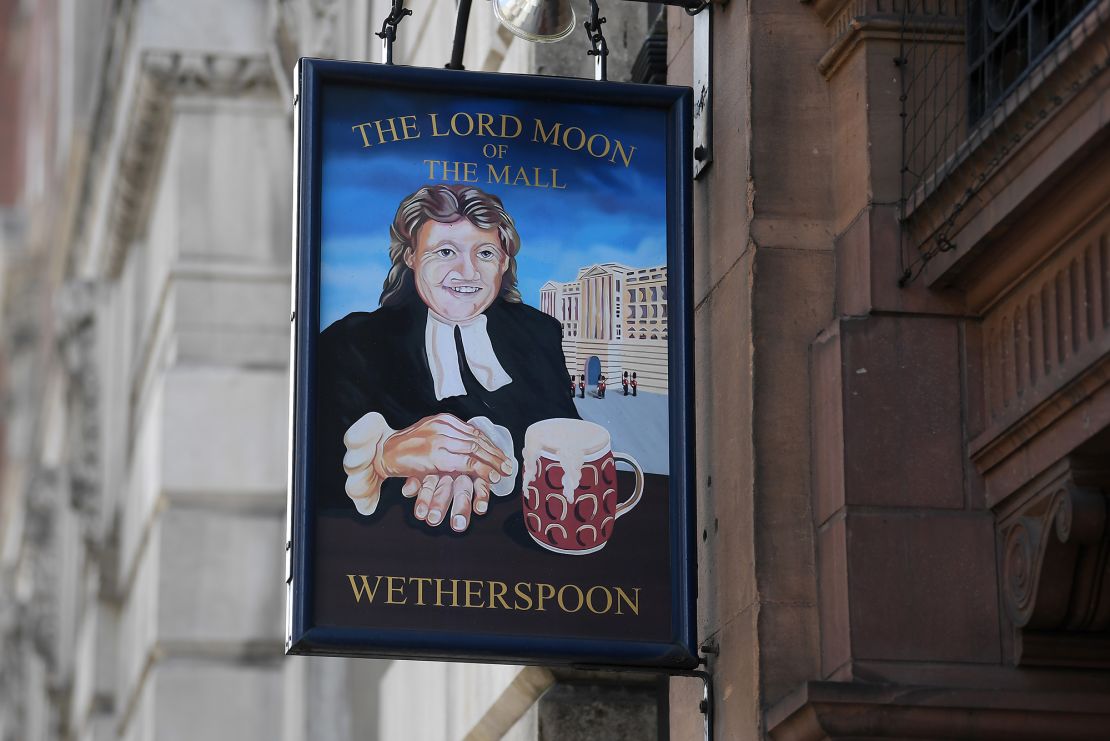
Unlike most chains, Wetherspoons don’t merely trade on their dependability, but also their individuality. Each pub name alludes to the building’s former life (The Bank Statement in Swansea), a famous figure from the area (The Alexander Graham Bell — inventor of the telephone — in Edinburgh), or in some cases a less-than famous one (The Admiral Sir John Borlase Warren in Nottingham). Beer is sourced from over 350 different brewers, no two bar line-ups the same. Some Brits happily settle in for a Wetherspoons pint multiple times a week. Others actively cross the street to avoid one.
So where did this huge, and hugely divisive, pub chain surface from in the first place?
Ground zero of Tim Martin’s operation opened in Muswell Hill, North London in 1979. Martin — a larger-than-life entrepreneur in all senses, who was born in Norwich, England, but grew up in New Zealand — called his first pub, rather unimaginatively, “Martin’s.” The name was printed on the plate glass frontage, but after a member of staff serendipitously put an A-board through said window, Martin took the opportunity to give his fledgling pub chain a quirky rebrand.
Recalling a well-meaning yet beleaguered teacher from his childhood, Martin renamed the pub “Wetherspoon.” (The “J D” was a nod to J.D. “Boss” Hogg from “The Dukes of Hazzard” TV series.) The rest was history. By 1992, the chain had grown to 50 pubs, opened its first airport branch (Heathrow), and was on its way to becoming a household name. Orwell entered the story about seven years into the business.
“The first I’d ever heard of George Orwell’s essay about the mythical Moon Under Water was in 1986 when we opened up pub number 10 in Stroud Green in North London,” Martin tells CNN. “A kind journalist wrote about our new pub [the White Lion of Mortimer] which had been converted from a car showroom, and said that it reminded him of the Moon Under Water.
“So I read the article and thought ‘ahh, I’ve got something in common with George Orwell’.” The journalist had rightly hit on parallels between Orwell’s dream pub and Martin’s real ones: The “no music” rule. Stout poured on tap. Somewhere “you can get a good, solid lunch”. Welcoming accompanied children in (although at a Wetherspoon they are not allowed, as Orwell suggested, to “fetch drinks for their parents”).
Martin duly opened a number of new Wetherspoons in the 1980s and ’90s as the Moon Under Water — a trend which he later dialed back after someone suggested it was “getting corny.” Even so, there are still 34 Moon Under Waters in the UK today, including the one in Watford where he’s going for a drink straight after this interview.
A Frankenstein’s monster of a pub chain
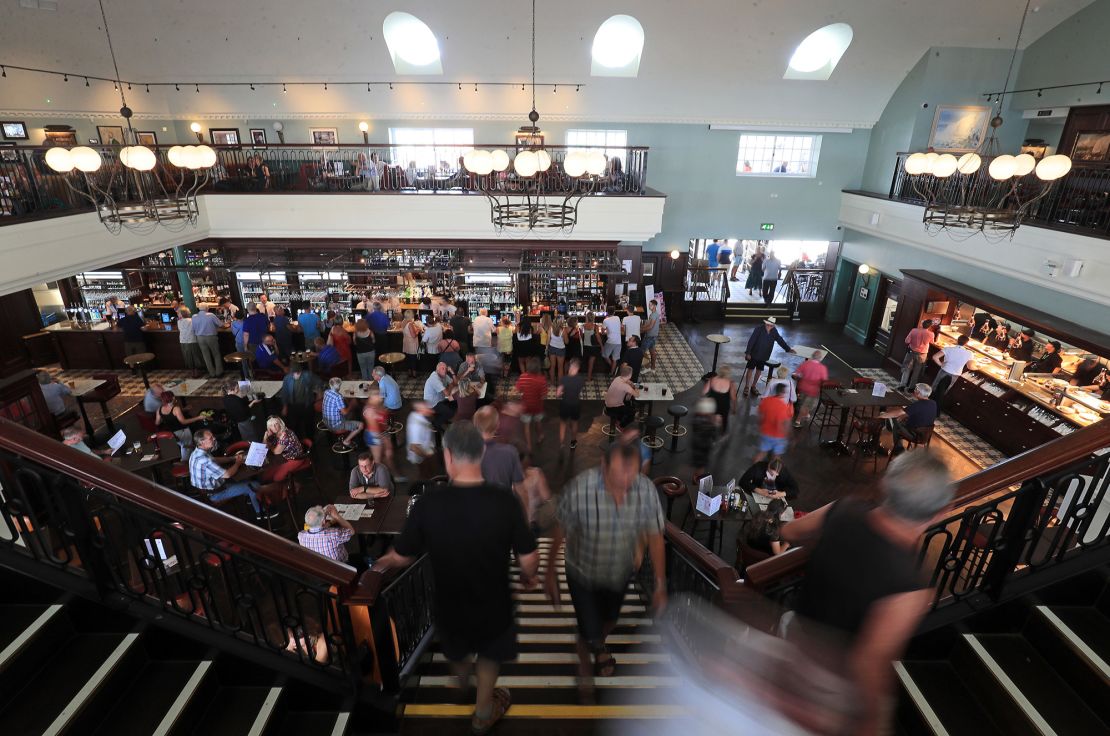
While the traditional British drinking establishment is a skew-whiff coaching inn or a shimmering Victorian gin palace, Wetherspoons tend towards the magisterial: renovated picture houses, theaters, banks, royal baths.
Veined marble columns and glass cupolas greet you at the Crosse Keys in the City of London. In Ramsgate, Kent, the grand Royal Victoria Pavilion backs out onto a golden beach and the North Sea beyond it. All very photogenic. Except that sticky tables, blaring fruit machines, microwaved food and mid-morning binge-drinking are also hallmarks of the chain.
The more you try to explain what a Wetherspoon is, the more you realize it must be seen to be understood. Martin — a man so lofty and square-jawed, he was once mistaken by a small child for Frankenstein’s monster — has created a freak of a pub empire, stitched together from the discarded limbs and organs of Britain’s architectural heritage. A beast of epic proportions like this comes imbued with its own legends.
Books have been written about the patterned carpets, each individually designed and woven, often with a nod to the surrounding local history. Drinkers spend years of their life questing to “complete” all the branches. A game has swept the internet, where customers post a picture of themselves at any Wetherspoon on a Facebook group; online strangers then order gifts of mountains of pies and pints to their table via the Wetherspoon app.
A much older Wetherspoon “game” is that of locating the bathroom. Given the immensity of many venues — and because the toilets are often buried deep in the bowels — this is a running joke. In 2023, someone posted a video of “going to the toilet in a Scottish Wetherspoon,” a mission that takes them past Edinburgh Castle, Angus cows, and to the summit of Arthur’s Seat, a local hill. “I’ve got lost trying to find my way back to the bar,” admits Tim Martin. “You can open the wrong door and end up in the Ladies’ [bathroom] if you’re not careful.”
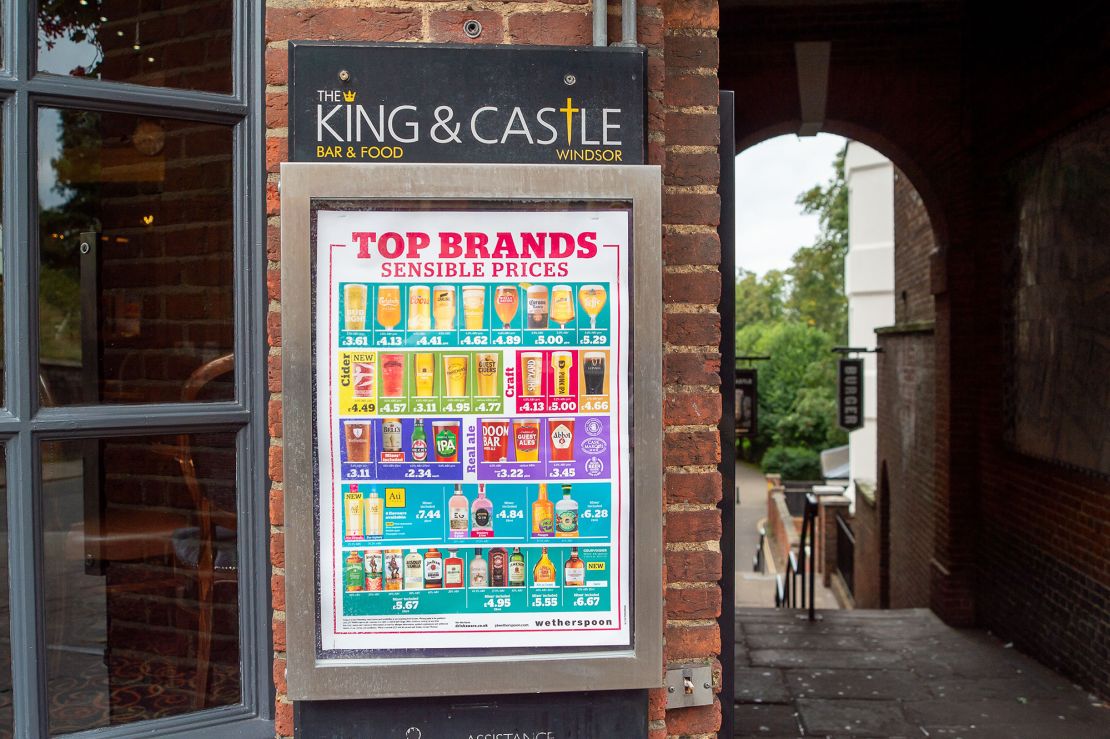
The venues might be cavernous, but the prices are small. “Mate refuses to buy round unless it’s in Wetherspoons” ran a recent headline on the satirical “Daily Mash” website. Glossy menus half the size of the table spill over with fry-ups, curries, wraps, puddings — most sold at prices you’d equate with some 20 years ago.
Free coffee refills aren’t a thing in British cafes but in a Spoons you can replenish your latte until you’re dancing on the coffered ceiling.
“A 92-year-old woman came up to me and said, ‘We do so love your pubs because we can afford to come out for two or three coffees,’” says Martin. In what is a financially wobbly era for the UK, it is no mystery why a Wetherspoon sign burns brightly like a beacon.
But not everyone is there for the coffee. With pints sometimes clocking in at under a single British pound (around $1.25), and pitchers of cocktails served at two for £15 (under $19), Wetherspoons can become honeypots for irresponsible drinking and rowdyism. Mass brawls, police vans and ambulances are not unknown.
In 2023, traffic was brought to a halt in Liverpool, when a bottle-smashing fight played out in front of the Thomas Frost pub. The image is at odds with Orwell’s make-believe establishment: “…drunks and rowdies never seem to find their way there, even on Saturday nights,” he wrote optimistically about his own Moon Under Water.
A quintessential taste of Britain?
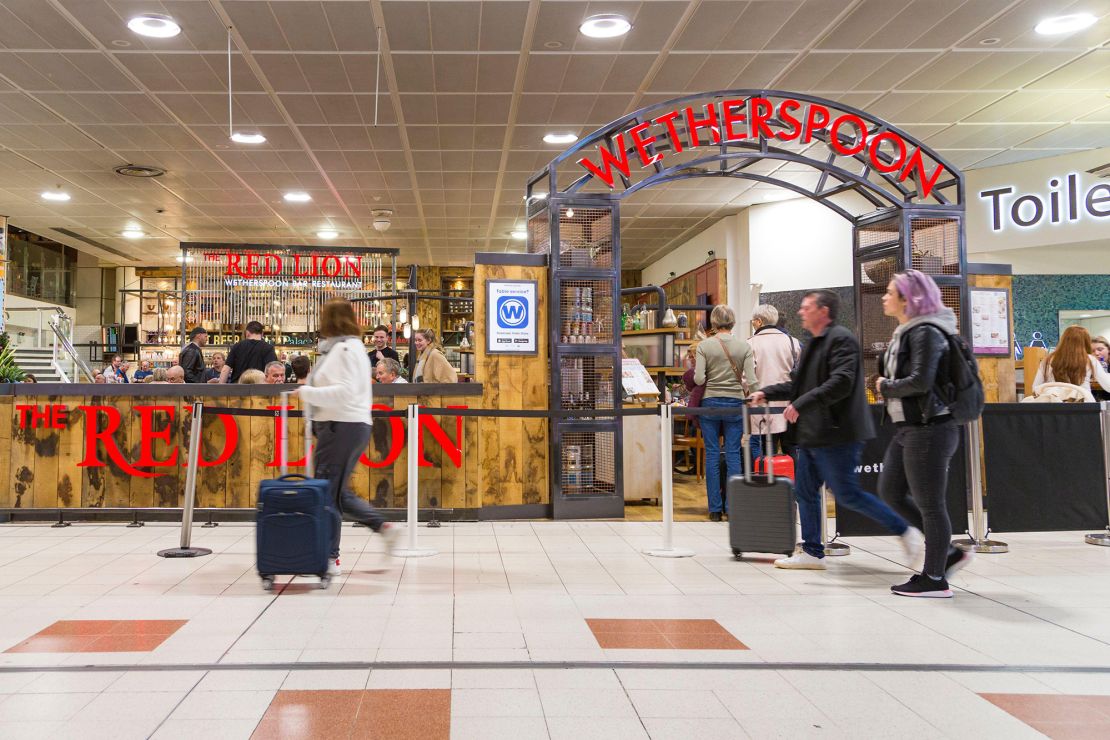
For many Brits jetting off on vacation, their last pint of lager or fried breakfast on home soil is in an airport Wetherspoon. Gatwick in South London has three — a miniature pub crawl in its own right. Conversely, for overseas tourists visiting the UK, a trip to a Wetherspoon can be a way to understand and ingratiate themselves with the country — not to mention get a thrifty brunch.
On YouTube and TikTok, wide-eyed North Americans wait for non-existent waiters, and wonder why table 117 is next to table 30. They peruse the menus and wonder if something drastic’s happened to the exchange rate since they landed. They snicker at the Wetherspoon concept of an “American cheeseburger.”
Tim Martin himself suggests a first-timer orders eggs benedict for breakfast, a southern fried chicken wrap for lunch, and steak and kidney pie or fish and chips for dinner. His recommended tipple — despite the fact Wetherspoon offers the widest range of real ales in the country — will always be the same: “Abbot Ale. Forty-five years of experience went into that answer,” says the self-labeled monogamous beer drinker.
Whatever’s being ordered though, Martin agrees with Orwell that the magic ingredient for any pub is atmosphere. “The thing about Wetherspoons pubs which differentiates them from many is that they have a very wide cross-section of customers. That’s what pubs used to do. They used to be the local melting pot which wasn’t the church.
“I think [overseas visitors] just like the pub atmosphere — that it’s looked upon as being a quintessential British thing that often isn’t available in that form in their own country.”
That may be so, yet some Brits have vowed never to set foot in one of Tim Martin’s establishments again. During 2016’s Brexit debate, the pub boss sided with the Vote Leave campaign, railing against the “undemocratic” nature of the European Union and donating £200,000 ($260,000 dollars) to support the effort that ultimately ejected Britain from the EU, with arguably catastrophic consequences.
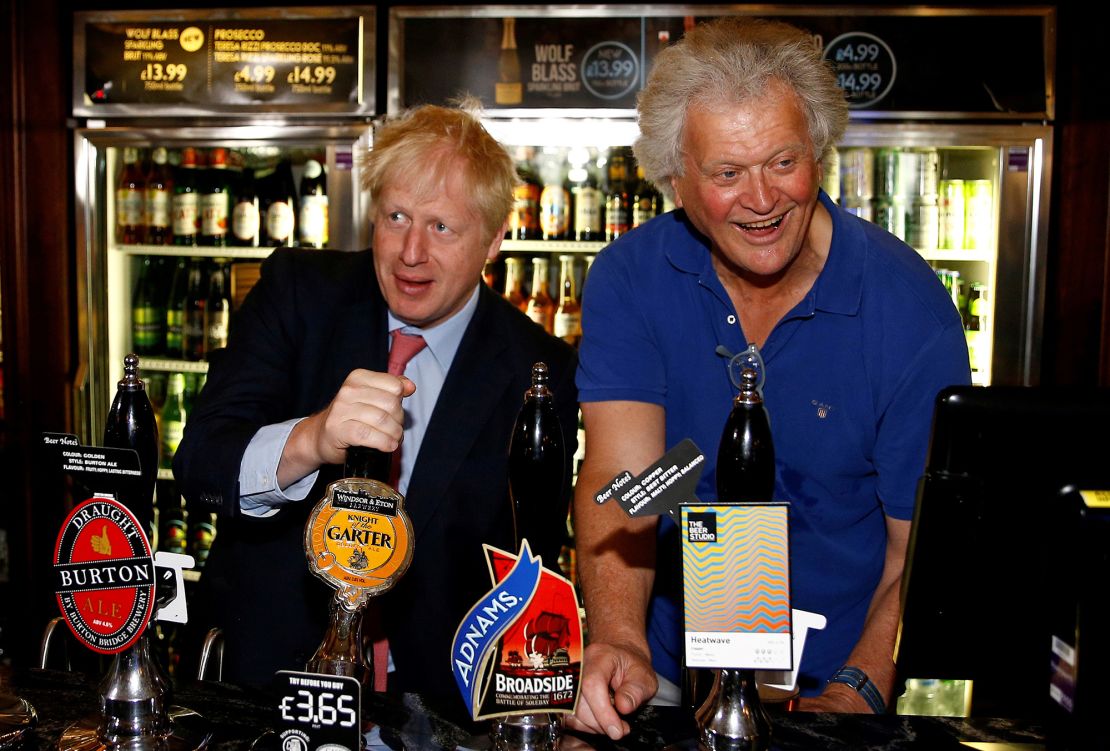
In the lead-up to the 2024 General Election, the right-wing British politician and Brexit campaigner-in-chief Nigel Farage used the Moon and Starfish Wetherspoon in Clacton as his de facto campaign HQ, only for his face to be met with an airborne protest milkshake on the steps outside.
Eight years after the Brexit vote, Martin is sticking by his guns. His argument was never anti-immigration, he says, insisting that the number of EU workers in his pubs is more or less the same as it was in 2016. “Quite a few of our pub managers who are Polish have gone back to Poland,” he says, “But there hasn’t been a massive change that I’ve noticed.”
When pushed, Martin is unable to put his finger on any legacies of Brexit that have specifically benefited his business, although he does suggest the UK has lately enjoyed one of the lowest unemployment rates in its history.
Something else that has plunged in recent years is the number of Wetherspoons. In 2021, there were 871 pubs, including expanding operations in Ireland; in the fall of 2024 that number had dipped by 70. Martin says this has nothing to do with Brexit, but instead, what he classifies as the one big mistake he made with the business.
“We copied the brewers of old who opened pubs close to each other, not realizing that that was because they had dray horses to deliver the beer, so they couldn’t go very far… It only took me about 35 years to discover that error!”
While thinning out its current clusters of pubs, then, might Martin take this opportunity to open some new pubs scattered further afield — say in an overseas airport? “I sometimes fly to America, so I’m hoping to have a pub in JFK Airport…” says Martin, before flashing a smirk to show he’s kidding.
Wetherspoons might be here, there and everywhere — but chances are, they’ll only be here, there and everywhere if you’re in the UK.


